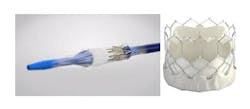Class I recall: Edwards Lifesciences SAPIEN 3 Ultra Delivery System due to burst balloons
The Food and Drug Administration has announced the Class 1 recall on all lots of the SAPIEN 3 Ultra Delivery System distributed by Edwards Lifesciences. The recall affects all patients in the U.S. who had a transcatheter aortic valve replacement procedure using the Edwards SAPIEN 3 Ultra Transcatheter Heart System starting January 3, 2019 to present.
Edwards Lifesciences has received reports of burst balloons during implantation procedures, which have resulted in significant difficulty retrieving the valve into the catheter and withdrawing the system from the patient, which may cause vascular injury, bleeding, death or surgical intervention.
Seventeen (17) injuries and one (1) death were reported at the time when Edwards initiated the Field Corrective Action in July 2019.
The Edwards SAPIEN 3 Ultra delivery system is a part of the Edwards SAPIEN 3 Transcatheter Heart Valve System. It is used to deliver and deploy the Edwards SAPIEN 3 Ultra transcatheter heart valve or the Edwards SAPIEN 3 transcatheter heart valve to replace a diseased aortic valve without open-heart surgery. The Edwards SAPIEN 3 Transcatheter Heart Valve System is indicated for use in patients with severe, symptomatic, aortic valve stenosis (narrowing of the heart’s aortic valve that restricts blood flow to aorta, the body’s main artery).
On July 9, 2019, Edwards Lifesciences sent an Urgent Field Safety Notice to customers with the following recommendations and instructions for physicians:
- When deploying the valve, inflate the balloon slowly and continuously throughout deployment. Hold for 3 seconds at full inflation. The delivery system requires a prescribed volume for THV deployment and proper function (11 mL, 17 mL, 23 mL, 33 mL).
- The following warning will also be added to the Edwards SAPIEN 3 Ultra Transcatheter Heart Valve System Instructions for Use (IFU): "Failure to use slow, controlled inflation and prescribed nominal inflation volumes may result in balloon rupture, difficulty retrieving the delivery system, and may require subsequent conversion to surgical intervention."
- If a balloon burst is suspected, do not attempt to pull back the delivery system into the sheath until you are prepared to conduct the following technique:
- Close stopcock to the delivery system and remove inflation device from stopcock.
- Continuously twist the handle in a clockwise direction (full 360o rotations) while gently pulling back the delivery system into the sheath tip. Verify delivery system tip has entered the sheath tip under fluoroscopy.
- DO NOT FORCE if resistance is met near or at the sheath tip. Forcing retrieval when meeting resistance could result in additional balloon material tearing or tip dislodgement. Consider utilizing other interventional techniques for retrieval (e.g., a snare).
- If successful in pulling the entire balloon into the tip of the sheath, withdraw the delivery system and sheath as a single unit completely from the arteriotomy while maintaining guidewire position. DO NOT attempt to pull the delivery system through the remaining length of the sheath.
- If resistance is still encountered, convert to surgery for device removal. Based on medical assessment of the size, tortuosity, and extent of calcification of the peripheral vessels, evaluate the risks and tradeoffs of carefully withdrawing the system into a more peripheral anatomy in order to allow a more localized procedure. Consider use of an occlusion balloon to mitigate bleeding risks.
